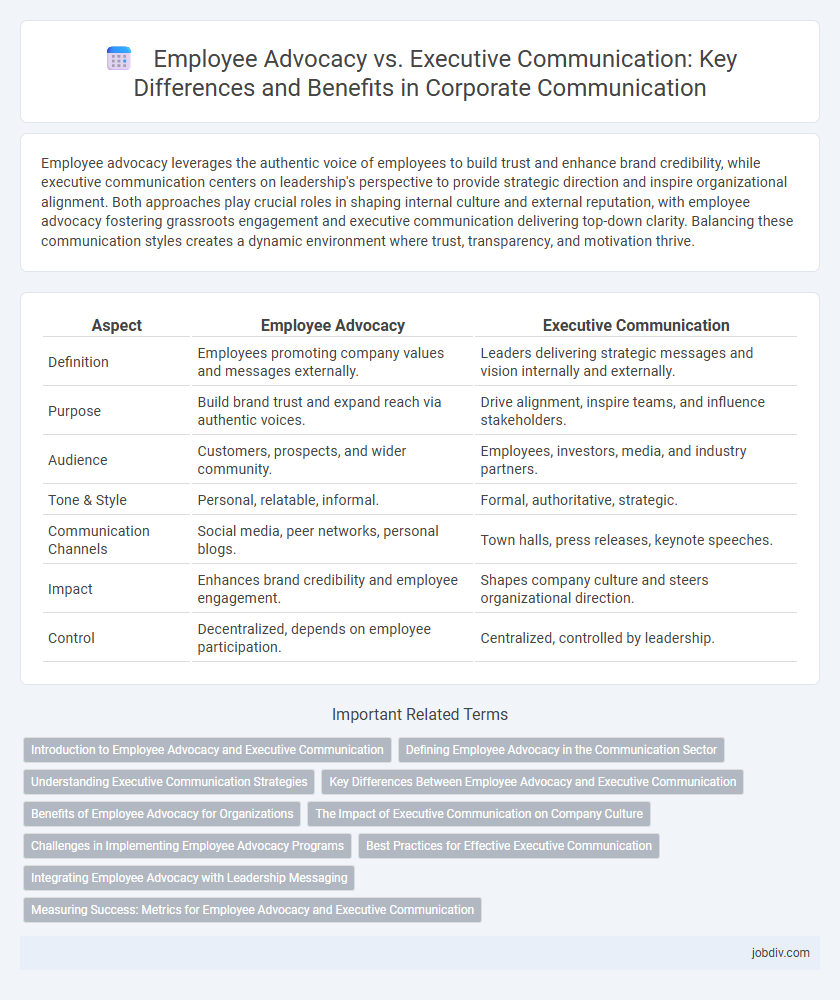Employee advocacy leverages the authentic voice of employees to build trust and enhance brand credibility, while executive communication centers on leadership's perspective to provide strategic direction and inspire organizational alignment. Both approaches play crucial roles in shaping internal culture and external reputation, with employee advocacy fostering grassroots engagement and executive communication delivering top-down clarity. Balancing these communication styles creates a dynamic environment where trust, transparency, and motivation thrive.
Table of Comparison
| Aspect | Employee Advocacy | Executive Communication |
|---|---|---|
| Definition | Employees promoting company values and messages externally. | Leaders delivering strategic messages and vision internally and externally. |
| Purpose | Build brand trust and expand reach via authentic voices. | Drive alignment, inspire teams, and influence stakeholders. |
| Audience | Customers, prospects, and wider community. | Employees, investors, media, and industry partners. |
| Tone & Style | Personal, relatable, informal. | Formal, authoritative, strategic. |
| Communication Channels | Social media, peer networks, personal blogs. | Town halls, press releases, keynote speeches. |
| Impact | Enhances brand credibility and employee engagement. | Shapes company culture and steers organizational direction. |
| Control | Decentralized, depends on employee participation. | Centralized, controlled by leadership. |
Introduction to Employee Advocacy and Executive Communication
Employee advocacy empowers employees to share authentic brand messages on their personal networks, amplifying reach and credibility. Executive communication involves leaders delivering strategic messages that shape company vision and stakeholder trust. Both approaches complement each other by leveraging internal voices to enhance organizational reputation and engagement.
Defining Employee Advocacy in the Communication Sector
Employee advocacy in the communication sector involves empowering employees to represent and promote their organization's brand, values, and messages through personal and professional networks. This strategy leverages authentic employee voices to enhance brand credibility, increase reach, and foster trust among target audiences. Unlike executive communication, which centers on top-level leadership messaging, employee advocacy drives grassroots engagement, amplifying organizational narratives from within.
Understanding Executive Communication Strategies
Executive communication strategies emphasize clear, consistent messaging from leadership to align organizational goals and inspire employee engagement. Employee advocacy leverages authentic stories from staff to enhance brand credibility and broaden reach, complementing executive efforts. Effective communication integrates leadership narratives with employee voices to foster trust and drive business success.
Key Differences Between Employee Advocacy and Executive Communication
Employee advocacy emphasizes grassroots promotion where employees share authentic brand messages, enhancing trust and organic reach. Executive communication centers on top-tier leadership delivering strategic vision and critical company updates, reinforcing authority and guiding organizational direction. The key difference lies in employee advocacy leveraging widespread peer influence, while executive communication relies on authoritative voice to shape corporate narrative.
Benefits of Employee Advocacy for Organizations
Employee advocacy enhances organizational trust by leveraging authentic voices from within the workforce, leading to increased brand credibility and wider reach across social media platforms. It drives higher engagement rates, as content shared by employees typically receives more interaction compared to corporate messaging, boosting overall marketing effectiveness. Empowered employees become brand ambassadors, fostering a positive company culture and attracting top talent through genuine storytelling and peer influence.
The Impact of Executive Communication on Company Culture
Executive communication shapes company culture by modeling transparency, trust, and accountability, which encourages employee engagement and alignment with corporate values. Clear and consistent messaging from leadership fosters a positive work environment, driving higher morale and productivity. This influence is often more direct and authoritative compared to employee advocacy, making it crucial for embedding cultural norms.
Challenges in Implementing Employee Advocacy Programs
Implementing employee advocacy programs faces challenges such as ensuring consistent brand messaging while empowering diverse employee voices, balancing transparency and confidentiality, and maintaining employee engagement over time. Unlike executive communication, which is centralized and controlled, employee advocacy requires scalable training and incentivization strategies to align individual content with corporate goals. Measuring the impact of employee-generated content on brand perception and ROI also presents a significant obstacle for organizations.
Best Practices for Effective Executive Communication
Effective executive communication hinges on clarity, transparency, and consistency to foster trust and align organizational goals across all levels. Utilizing storytelling techniques and tailoring messages to diverse audiences enhance engagement and reinforce the executive brand. Incorporating regular feedback loops and leveraging multiple communication channels ensure messages resonate and drive actionable outcomes.
Integrating Employee Advocacy with Leadership Messaging
Integrating employee advocacy with leadership messaging amplifies organizational communication by aligning authentic employee voices with strategic executive narratives. This synergy enhances brand credibility and fosters trust through consistent, transparent messages that resonate across internal and external audiences. Leveraging employee advocacy alongside executive communication drives engagement, empowerment, and a unified corporate culture.
Measuring Success: Metrics for Employee Advocacy and Executive Communication
Measuring success in employee advocacy involves tracking metrics such as engagement rates, content shares, and conversion rates driven by employee-generated content, which indicate the influence on brand awareness and trust. Executive communication success is evaluated through internal survey feedback, message retention levels, and leadership visibility metrics, reflecting alignment with organizational goals and employee sentiment. Combining these metrics provides a comprehensive view of communication impact across both grassroots and leadership channels.
Employee Advocacy vs Executive Communication Infographic

 jobdiv.com
jobdiv.com